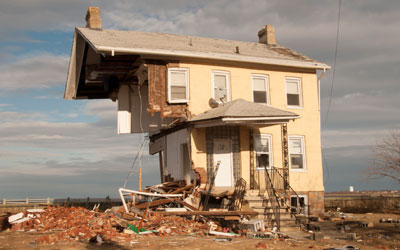
 |
|
The remains of a home in Union Beach, N.J., stand as a stark reminder of the power after Hurricane Sandy swept through the area. (Photo by Patsy Lynch/FEMA) |
"What I need right now is a dollar and a dream," said Frank Bain of Sea Bright, N.J., whose uninsured hardware store stock was destroyed by five feet of Sandy's water. "We'll do the best we can and the best we can for everyone. But no one can honestly say we have a plan yet, none of us."
New Jersey scores high among states for safe residential construction through its strict enforcement of modern building codes, according to a report card compiled earlier this year by the Insurance Institute for Business & Home Safety, an industry-funded group.
Sea Bright has implemented protective measures over the years, most notably a 15-foot-high sea wall that was built in the 1940s and runs along most of the three-mile-long town. The town has water pumps, runoff inlets and bulkheads to mitigate periodic flooding. None of the existing measures did much to protect the town's 1,400 mostly year-round residents against Sandy. Over the course of a few hours on Oct. 29, a 13-foot storm surge, propelled by 100-mile-per-hour winds, tore through town. Seawater filled homes, businesses and streets with a tsunami of sand that clogged drainage pipes and runoff inlets. By the next morning, the sea had receded but the sand remained.
Authorities have condemned dozens of buildings. Officials put preliminary estimates of building damage at nearly $400 million. One decision is whether Sea Bright can afford to rebuild itself. Of the town's 1,211 residences and dozens of businesses, a large percentage has flood insurance through the 44-year-old National Flood Insurance Program, according to government figures and local estimates. But the program, which operates under the Federal Emergency Management Agency, pays a maximum of $250,000 per residential structure and $100,000 for contents. Robert Adler, Sea Bright's town architect, said that won't be enough for homeowners to rebuild. Payouts to businesses are capped at $500,000 for structures and $500,000 for contents.
"The biggest challenge is financial," said Adler. "Where will these people get the additional money to rebuild? We will either have an amazing renaissance or a colossal failure. There's not much room in between."



